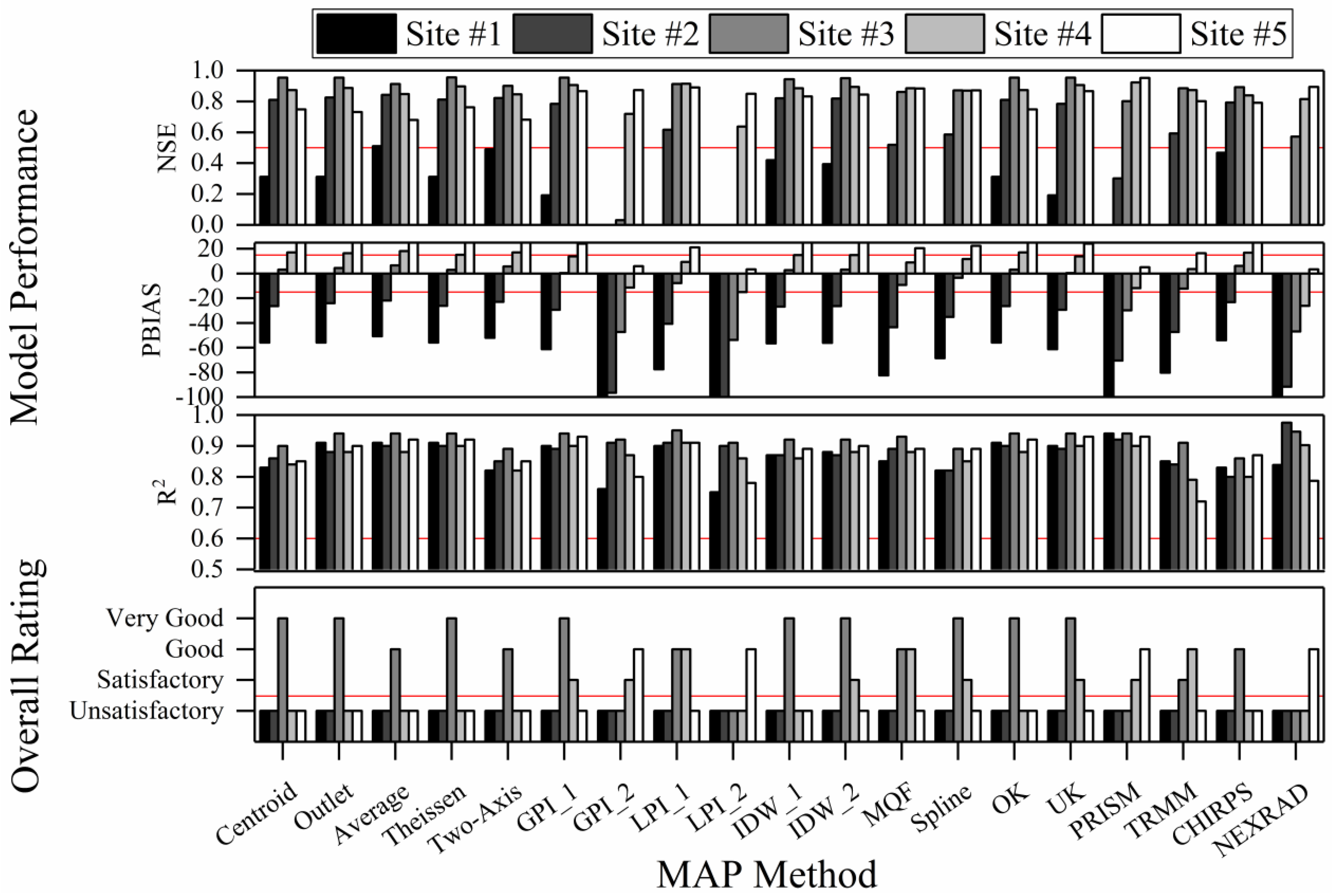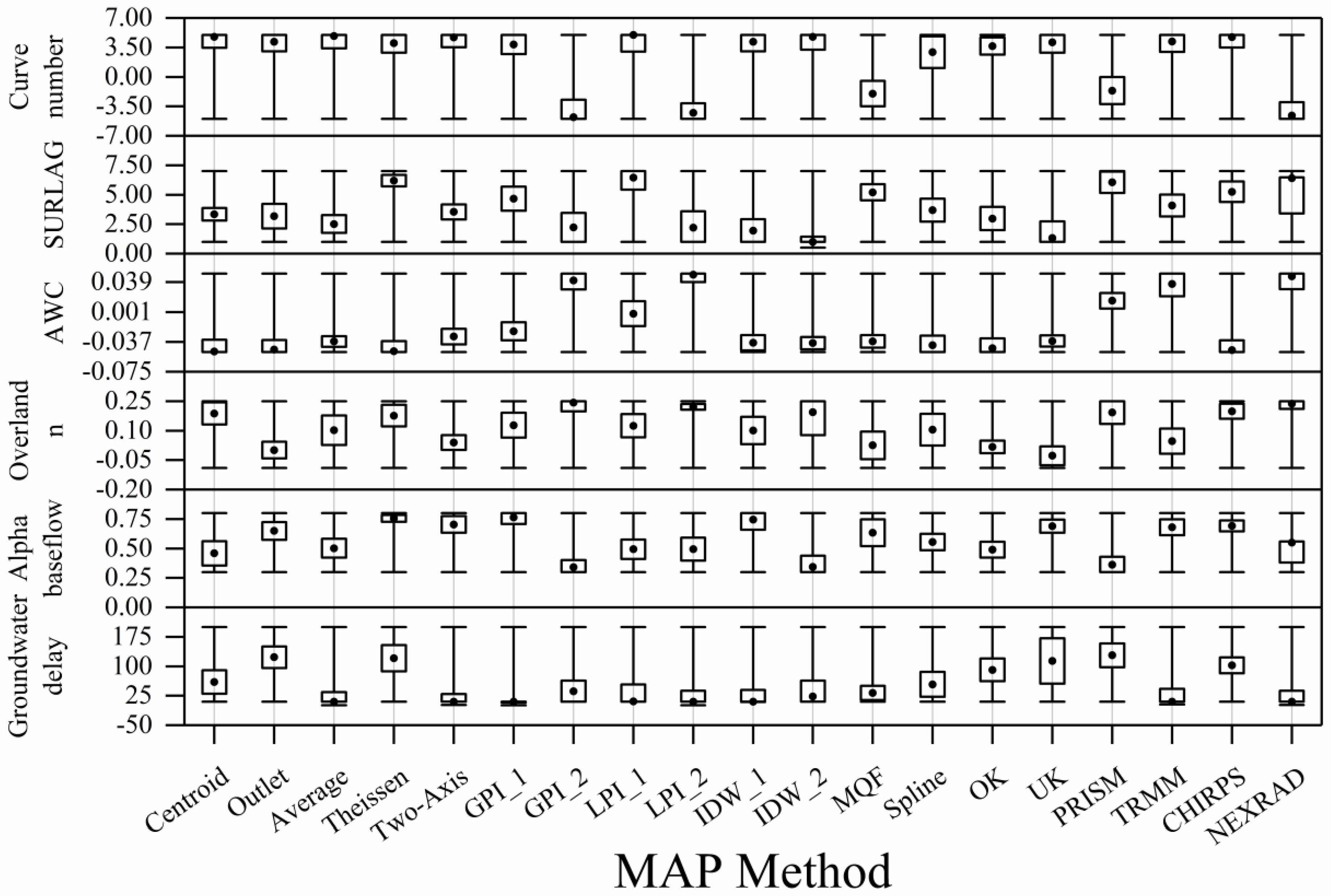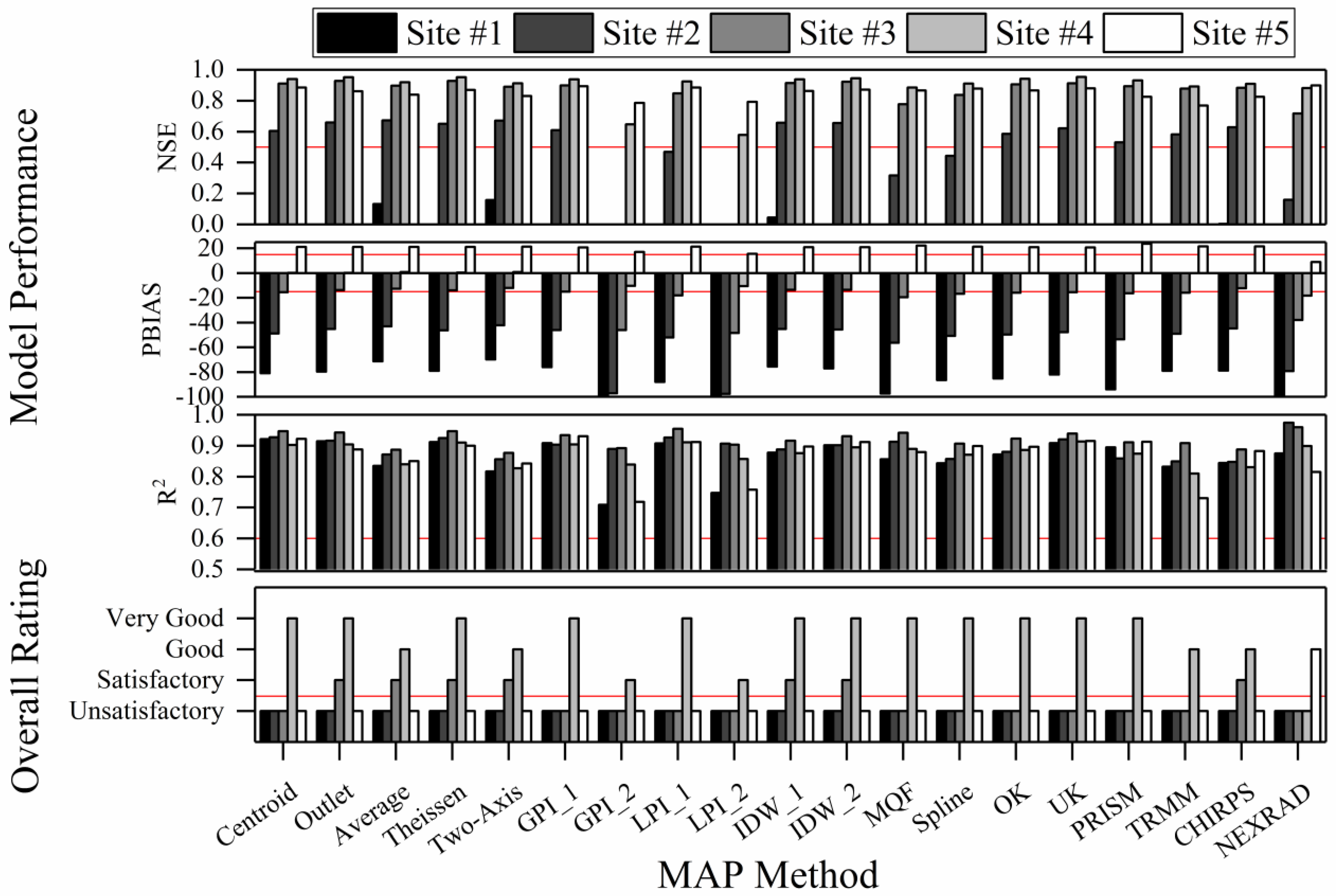1. Introduction
Accurate mean areal precipitation (MAP) estimates are essential forcing data for hydrologic models [
1,
2]. However, quantifying MAP can be confounding, particularly when metrological conditions, topography, and/or land use influence the spatiotemporal variability of precipitation [
3]. There are multiple techniques that have been used to estimate MAP including (but not limited to) nearest neighbor (or proximate gauge), direct weighted average, surface-fitting, and remote sensing (e.g., radar and satellite-based) methods. Selecting the most suitable method to estimate MAP can be daunting, in part, because there are so many methods to choose from, each with distinct strengths and weaknesses.
Studies have shown a correlation between gauge density and the accuracy of MAP estimates [
4]. In regions without observed data, MAP can be simulated using statistical weather generators. However, remotely sensed data may be more accurate in ungauged watersheds [
5]. In minimally gauged regions, where at least one gauge is available, the proximate gauge method can be used to estimate MAP. Using this method, MAP is assumed to be equal to the total rainfall from the gauge nearest to the centroid of a given sub-basin [
6]. However, uncertainty increases with the distance from the point of measurement making this approach problematic for many applications [
4]. Model uncertainty can be reduced by increasing the gauge density [
4]. In regions with more than one gauge, precipitation data can be interpolated to estimate MAP using direct weighted averaging methods, or surface-fitting methods. Some examples of direct weighted averaging methods include arithmetic average, Thiessen polygons [
7], and the two-axis method [
8]. Popular surface-fitting methods include polynomial surface [
9], spline surface [
9], inverse-distance interpolation (IDW) [
10], multiquadric interpolation [
9], optimal interpolation/kriging [
11], artificial neural networks [
12,
13,
14], and hypsometric methods [
15].
While there are many MAP methods, choosing the appropriate method for a given application is critical. For example, a relatively simple arithmetic average may be appropriate for a spatially lumped hydrologic modeling application in a small watershed of relatively homogenous topography and land use, but a more computationally complex hypsometric method (for example: The Parameter-elevation Regression on Independent Slopes Model (PRISM)) may be well-suited for a spatially distributed hydrologic modeling application in a mountainous region [
15,
16]. Furthermore, an inverse-distance interpolation method may be a more appropriate approach for a physically-based semi-distributed model such as the Soil and Water Assessment Tool (SWAT) [
17].
Similar to the MAP method selection, it is also important to select the most appropriate hydrologic simulation model for the application. While there are multiple hydrologic models to choose from, SWAT is currently one of the most popular hydrologic models world-wide with over 2500 publications in print in over 400 different scientific journals [
18]. The SWAT model is used internationally for applications including water resource management, pollutant loading estimates, receiving water quality, source load allocation determinations, and conservation practice efficacy [
5,
19]. A complete description of the SWAT model can be found in the Soil and Water Assessment Tool Theoretical Documentation [
6], and literature reviews highlight various strengths and weaknesses of the model [
5,
19,
20]. A SWAT Literature Database can be accessed via the internet at (
http://swat.tamu.edu/publications/swat-literature-database).
While there are numerous SWAT modeling publications, there are relatively few publications on the topic of precipitation input effects on the SWAT model output. However, the effects of different precipitation inputs on the SWAT model output have been tested using remotely sensed data [
21,
22,
23,
24,
25] and the centroid method currently used to estimate MAP in SWAT [
4,
17,
21,
22,
23,
24,
26,
27]. For example, Tuo et al. [
26] tested the influence of the centroid method, IDW, and two satellite-based data sets (the Tropical Rainfall Measuring Mission (TRMM), and Climate Hazards Group InfraRed Precipitation with Station data (CHIRPS)) on SWAT simulated stream flow in the alpine Aldige river basin of north-eastern Italy. Results showed that the IDW method was the most accurate method tested for SWAT model precipitation input, and the CHIRPS satellite-based data set produced ‘satisfactory’ simulations of stream flow. Szczesniak and Pinieski [
17] used four methods including the nearest neighbor technique, Thiessen polygons, IDW, and ordinary kriging (OK) in the Sulejów Reservoir Catchment located in Poland. The results showed the OK method as the most accurate interpolation method for the SWAT model. Additionally, the OK, IDW, and Thiessen methods were more accurate than the centroid method, currently the default method, used in SWAT with median differences in Nash-Sutcliffe values ranging from 0.05 to 0.15. Masih et al. [
4] tested the IDW method versus the default method used in SWAT in mountainous semiarid catchments in the Karkheh River basin, Iran. The IDW method resulted in an improved SWAT model output particularly in smaller watersheds with drainage areas ranging from 600 to 1600 km
2. Ultimately, the results from the literature consistently show that the centroid method currently used in SWAT is unsatisfactory for most applications.
Many methods used to estimate MAP have been reviewed in cross-validation studies [
28,
29,
30,
31]. Generally, the results showed that more complicated surface-fitting methods generate better results relative to direct weighted averaging methods. However, the computational demands of the more complex surface-fitting methods can be a disadvantage. A less frequently applied alternative approach to cross-validation analysis of MAP models is to validate the models against a hydrologic model simulated stream flow [
17]. There remains a great need for a hydrologic model validation of multiple MAP methods across the array of contemporary MAP modeling techniques (i.e., proximate gauge, direct weighted average, surface-fitting, and remotely sensed methods). In addition, Masih et al. [
4] and Ly et al. [
27] concluded that there is a need for further testing of the effects of precipitation input on the SWAT model output.
In response to the call for further investigation, a novel split-site validation of multiple MAP techniques (e.g., proximate gauge, direct weighted average, surface-fitting, and remotely sensed methods) is presented using observed precipitation and stream flow data collected at nested-scales in a mixed-land-use catchment. The overarching purpose of the current work was to show which MAP method(s) are best-suited for hydrologic simulation modeling efforts so that managers can more readily focus on viable efforts in other developing watersheds with similar physiographic characteristics as the study catchment. The objectives of the current work were to: (i) quantify the effects of 19 different MAP methods on uncalibrated SWAT model performance for stream flow, and (ii) perform a split-site validation of SWAT model simulated stream flow using multiple years of observed stream flow data collected at nested-scales from a mixed-land-use watershed of the central USA.
4. Conclusions
While there are many MAP methods to choose from, selecting the most accurate method for a given modeling application is essential for realistic hydrologic simulations. Internationally used alternative proximate gauge and direct-weighted average MAP estimation techniques may not be the most accurate MAP techniques for semi-distributed watershed-scale continuous time hydrologic models like the Soil and Water Assessment Tool (SWAT). The inverse distance weighted, linear local polynomial interpolation, and the multiquadric function surface-fitting methods were the most accurate methods for the SWAT model estimates of stream flow in this study. Conversely, the 2nd order polynomial MAP methods were the least effective, with unsatisfactory SWAT model performance at daily, monthly, and annual intervals.
Remotely sensed precipitation input data for hydrologic models are useful because the majority of the Earth’s land surface is not monitored with networks of precipitation gauges. The PRISM data set was associated with ‘satisfactory’ uncalibrated SWAT model performance for the monthly stream flow. Additionally, all satellite-based datasets tested resulted in a rating of ‘good’ for annual stream flow following SWAT model calibration, except for the NEXRAD data that overestimated the total precipitation. Thus, the results support the use of the PRISM data set for ungauged watersheds regionally in catchments that may have stream flow gauges, but lack the precipitation monitoring sites to estimate MAP using surface-fitting methods. Additional model performance testing and validation will be needed as satellite-based precipitation data sets are updated. Networks of ground-based precipitation monitoring sites will also continue to be important for ground truthing.
Split-site SWAT model validation results indicated a need for multiple stream flow gauging sites in watersheds with notable differences in soils, vegetation, land use, and/or underlying geology. Model calibration at the watershed outlet alone was coupled with model uncertainty that increased with the distance from the urban site of calibration to the agricultural headwaters (−68% to −160% overestimations in stream flow) due to differences in watershed characteristics and two Level II Ecoregions. Collectively, the results highlight a need for networks of distributed meteorological monitoring sites, coupled with nested hydrologic gauging sites where multiple years of hydroclimate data can be collected to: (i) accurately quantify MAP using surface-fitting methods, (ii) continue to validate remotely sensed data sets, and (iii) partition large basins into sub-basins each with different dominate watershed characteristics for accurate watershed-scale continuous-time hydrologic model simulations.










